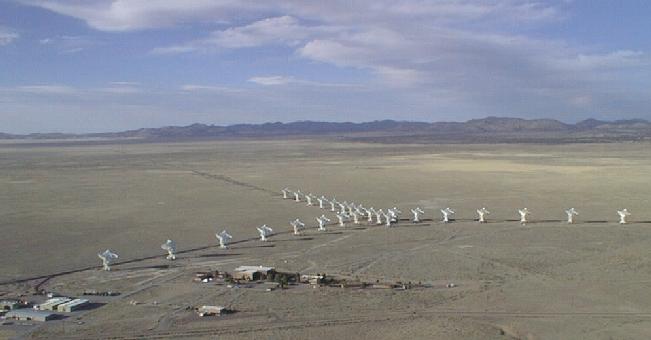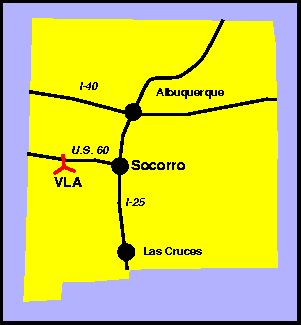Versión en Español
 Photo by Dave Finley, courtesy NRAO/AUI An aerial view of the VLA with its antennas close together, looking toward the North-Northeast. |
|
How to Get HereThe VLA is located 50 miles west of Socorro on U.S. Highway 60. From U.S. 60, turn South on NM 52, then West on the VLA access road, which is well marked. Signs will point you to the Visitor Center. What You Will SeeThe Visitor Center is open every day from 8:30 a.m. to dusk. As you enter, a sign will point you toward the theater, a good place to begin your tour. The 9-minute video presentation was produced in 2002. It provides an understandable overview of radio astronomy, interferometry, and the VLA itself. You will then want to explore our exhibits, to learn more about radio astronomy and the role the Very Large Array and other NRAO telescopes play in current research. A 5-minute silent video will show you how we move antennas. Another video slide show describes the Very Long Baseline Array and how it works. A Small Radio Telescope located just outside the back window tracks the Sun and produces a crude image. Near the back door you will find a brochure to guide you in the walking tour that will take you past our Whisper Gallery to the base of one of the 230-ton antennas. From there you will climb up to the observation deck for a view of the array itself, as well as a look at the new prototype antenna we are testing for the ALMA project. The walk returns you to the Visitor Center where you are welcome to pick up an order form for merchandise, or you can purchase your souvenirs from home! We suggest you make a right-hand turn as you leave the parking lot and head for the tall building, following the AAB (Antenna Assembly Building) Tour signs. As you cross the railroad track there is a parking lot on your left. From there you can view our 28th antenna that is undergoing routine maintenance. You will also (most of the time!) get to see one of the transporters that is used to move the antennas. You are welcome to take photographs of everything you see, but PLEASE KEEP YOUR CELL PHONE TURNED OFF! (It interferes with our observing) Guided ToursOnce each quarter we offer guided tours to the general public. Click here for the date of the next scheduled tour. During the summer, our summer students provide tours on weekend. The tours are free and no reservations are needed. For educational groups, we provide tour guides (if available!) from among staff members who volunteer for this duty. We need at least two weeks' notice to arrange a guided tour. If you're thinking about arranging an educational tour, look at our information on bringing your class to the VLA. Then give our Education and Public Outreach office a call at (505) 835-7243 to schedule the tour. Facilities, Food, Weather, Etc.The Visitor Center has restrooms, water fountains and a soft-drink machine. No food is available at the VLA site. The nearest restaurants are in Magdalena, about 25 miles to the east, and Datil, about 20 miles to the west. Many restaurants, as well as lodging, are available in Socorro, an hour's drive from the VLA. Lodging also is available in Magdalena. There are two picnic tables located near the Whisper Gallery and several roadside tables along Highway 60 east of the array. If you are picnicking in your RV, please don't use your microwave oven as it interferes with our observing. Camping is available at the Datil Well BLM campground in Datil and the Water Canyon campground between Magdalena and Socorro. The VLA is at an elevation of 7,000 feet. At this elevation, the weather can be considerably colder than that at lower elevations. Snow is possible at the VLA from September through May. Check weather reports before your trip. During Fall, Winter and Spring, jackets or coats usually are needed, and warm hats and gloves are advisable during the colder periods. Can't make it to New Mexico?Take a virtual tour of the Very Large Array, courtesy of students from Socorro High School.While in the Southwest, you may want to visit some other astronomical observatories. For information about observatories in this region, check out the Web page of the Southwestern Consortium of Observatories for Public Education (SCOPE) For more information: |

